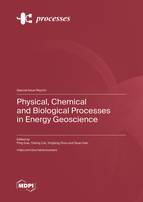Physical, Chemical and Biological Processes in Energy Geoscience
A special issue of Processes (ISSN 2227-9717). This special issue belongs to the section "Energy Systems".
Deadline for manuscript submissions: closed (15 October 2023) | Viewed by 18731
Special Issue Editors
Interests: sedimentation and diagenesis of fine-grained sediments; deep shale gas; organic petrology; petroleum geochemistry; sedimentary geochemistry
Special Issues, Collections and Topics in MDPI journals
2. Coal Reservoir Laboratory of National Engineering Research Center of Coalbed Methane Development & Utilization, Beijing 100083, China
Interests: geological process; energy geoscience; geo-energy resources evaluation; unconventional oil and gas source rock; reservoir fluids performance; micromechanical properties; scale-span structure; oil/gas/water adsorption/desorption
Special Issues, Collections and Topics in MDPI journals
Interests: digital rock physics; CO2 geological storage and utilization; multiscale porous material characterization
Special Issues, Collections and Topics in MDPI journals
Special Issue Information
Dear Colleagues,
Recently, an increasing number of countries have pledged to cut greenhouse gas emissions in order to prevent the worst consequences of the climate crisis. Strategies to actualize this target include the use of low carbon energy and renewable energy (e.g., geothermal resources), as well as the geological storage and utilization of CO2. Since this energy transformation requires a relatively long time and the current associated technologies still need to be updated, the replacement of high-carbon fossil energy with low-carbon energy and renewable energy will be gradual. The relatively low carbon fossil energy, natural gas, is associated with relatively low emissions of greenhouse gas (i.e., CO2), which plays an important role in the energy transformation from fossil energy to renewable energy. Therefore, unconventional gases (e.g., shale gas, coalbed methane) as low carbon energy accounts for an increasing proportion in the total yields of global natural gas. The formation, occurrence, and flow processes of natural gas in the multiscale reservoirs are becoming new hot research topics. In addition, the fluids behaviors of oil, gas, and water in porous media (e.g., coalbed methane, shale gas, and geothermal energy reservoirs) and the associated complex physical, chemical, and biological processes will be particularly important for geo-energy exploration and exploitation together with the carbon capture, utilization, and storage. We therefore call for submissions to be included as part of a Special Issue covering the new advances in physical, chemical, and biological processes in energy geoscience, especially for unconventional gases and geothermal energy. Novel, original research articles and reviews are all welcomed. Potential topics include but are not limited to the following:
1. Depositional and diagenetic processes of geo-energy reservoirs.
2. Formation and evolution mechanism of pores and fractures.
3. Characterization of organic and mineralogical properties of unconventional geo-energy.
4. Fluids flow behaviors in porous media under geological conditions.
5. Exploration, development, and utilization of geo-energy resources (including oil, gas, and geothermal resources).
Dr. Ping Gao
Prof. Dr. Yidong Cai
Dr. Yingfang Zhou
Prof. Dr. Quan Gan
Guest Editors
Manuscript Submission Information
Manuscripts should be submitted online at www.mdpi.com by registering and logging in to this website. Once you are registered, click here to go to the submission form. Manuscripts can be submitted until the deadline. All submissions that pass pre-check are peer-reviewed. Accepted papers will be published continuously in the journal (as soon as accepted) and will be listed together on the special issue website. Research articles, review articles as well as short communications are invited. For planned papers, a title and short abstract (about 100 words) can be sent to the Editorial Office for announcement on this website.
Submitted manuscripts should not have been published previously, nor be under consideration for publication elsewhere (except conference proceedings papers). All manuscripts are thoroughly refereed through a single-blind peer-review process. A guide for authors and other relevant information for submission of manuscripts is available on the Instructions for Authors page. Processes is an international peer-reviewed open access monthly journal published by MDPI.
Please visit the Instructions for Authors page before submitting a manuscript. The Article Processing Charge (APC) for publication in this open access journal is 2400 CHF (Swiss Francs). Submitted papers should be well formatted and use good English. Authors may use MDPI's English editing service prior to publication or during author revisions.
Keywords
- depositional process
- diagenetic process
- unconventional gases
- geothermal energy
- fluid transport and storage process
- geo-energy recovery process









